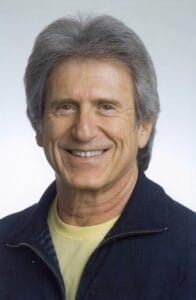Born in Texas to a doctor father, Ochs grew up in Ohio, but still moved around as his dad took jobs at various hospitals. “I went to three high schools in four years,” he said. “I’d go to school, didn’t know anybody. I’d come home and play records.” He loved records: he took a job as a delivery driver for a record company, and took his pay in records, rather than cash. His older brother, Phil Ochs, was a songwriter and protest singer (Phil would say “topical singer”). After graduating from Ohio State University in 1966, Ochs was Phil’s manager for two years, and in 1969 moved to Los Angeles to take a job as Columbia Records’ West Coast Manager of Publicity. He took the salary, and still collected plenty of records.

Like his father, Ochs jumped around to different jobs, working as a publicist for other labels, including Shelter and ABC Records. In addition to records, he started collecting photos of the artists — publicity shots were part of his job. The hobby became a bit of an obsession: he’d scoop up any rock ’n’ roll photo collection he could get his hands on from estate sales, musicians, photographers, defunct record labels, and retired record label executives. The bigger his collection got, the easier it was to get more. “I use this concept which could come off as BS, but I use it to talk people out of stuff,” he said. “It’s the greater good concept: ‘It should be in the archives and you know it.’”
Not that he called it an “archive” at first. It was just his collection, though he’d let music writer friends use some of his photos to illustrate their articles, such as Lester Bangs, who wrote for Creem and Rolling Stone. But then two things happened: First, the Los Angeles Free Press illustrated an article with one of his photos and attributed it to the “Michael Ochs Archives”. Then, Dick Clark used some of his photos for a TV special, and sent a check for $1,000, even though Ochs hadn’t asked for any payment. The “Michael Ochs Archives” sounded good: he made it official.
By the 1980s, his collection was so vast he published a book, Rock Archives: A Photographic Journey Through the First Two Decades of Rock & Roll. Now long out of print, expect to pay more than $100 if you can find a used copy (Amazon has three as I write this. *) The New York Times was wowed by the book (“an amazingly comprehensive photograph collection” which “offers glimpses of just about everyone seen or heard from during rock’s first two decades.”) Ochs taught a History of Rock and Roll class at UCLA, and hosted his own “Archives Alive” radio show on KCRW radio from Santa Monica, and was brought in on several Hollywood films as Music Coordinator.
In the 1990s, record labels started reissuing albums on CD, ushering a boom in older music — and a demand for photos for their booklets. And, of course, other books looking at the history of rock. For a 2006 article, the New York Times went through scores of such books, and found around half had photos from the Michael Ochs Archives, which had grown to house more than 2 million images in a high-security, temperature-controlled warehouse. In 2007, he sold his collection to Getty Images. Michael Andrew Ochs had been diagnosed with Parkinson’s disease in 2000, and also had heart and kidney problems. None of that killed him: Ochs died from COPD at his home in Los Angeles on July 23. He was 82.
